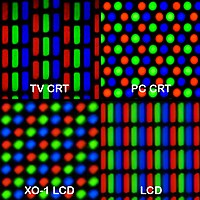Talk:Pixel geometry
| This article is rated Stub-class on Wikipedia's content assessment scale. It is of interest to the following WikiProjects: | ||||||||||||||||||||||||
| ||||||||||||||||||||||||
Untitled
[edit]I think there's an error in the lower picture.
The "TV-CRT" and "PC-CRT" images appear to be swapped.
Notice the "TV-CRT" image has neat vertical RGB columns, while the "PC-CRT" image has the honeycomb triangular pattern.
This directly contradicts the text above. In the text, televisions are described as needing the triangular pattern, for smoothness of moving images. Monitors are described as needing the vertical columns, for crisp display of sharp edges. In the image, exactly the opposite appears. --Kreline (talk) 21:59, 24 September 2008 (UTC)
This article needs a major, almost complete, rewrite.
[edit]There are no rules that dictate (or evidence that proves) that diagonal or triangular pixel geometry positively affects the perception of "variation" in a moving image. There may be a reduction in perceived aliasing along diagonal lines and curves, but the effect is only shifted to horizontal and vertical lines.
Additionally, the article definitively states that (all) monitors use vertically striped pixel geometry. This is false. In fact, it is far more common to find non-striped pixel geometries on even mid- to higher-end computer monitors (mostly CRTs, but also some LCDs) than on televisions using any given display technology, at least on models released in the last 10 years or longer. The article for "shadow mask" correctly states as much.
It should also be noted that the example photograph (not the diagrams), shared with the article for "subpixel rendering" (another article in need of some help), is potentially misleading and poorly labeled. Kreline is right to notice the discrepancy. The image also demonstrates the difference between an unmentioned hybrid design (vertical stripes in alternating diagonal placement, as shown in the "TV CRT" portion of the image) and a conventional in-line pixel array (as in the "LCD " portion, but which can also be found in CRTs).
Finally, the brightness benefits of stripes over dot-based geometries might be nice to mention, unless this is best left to add to the article for "Trinitron." 69.181.174.166 (talk) 00:26, 27 January 2009 (UTC)
- That's great. If you cite your sources, you should have no trouble getting a rewrite accepted here. Dicklyon (talk) 00:38, 27 January 2009 (UTC)
Is the illustration for diagonal geometry correct?
[edit]I am suspicious of it because this is a schematic drawn by someone for Wikipedia and I have seen no example of such configuration in any of the pictures that are actually taken by a microscope, besides I imagine rendering a correct image with that system wouldnt be very easy.

What I guess could be the real form of diagonal pixel geometry is what's shown here under TV CRT, which is pretty much Stripes configuration except the rows dont line up. Conzeit (talk) 18:48, 12 February 2009 (UTC)
Printing
[edit]Per this discussion:
You might want to mention in the article that pixel geometry is not meaningful for CMYK subtractive printing. SharkD Talk 21:54, 5 January 2017 (UTC)
- Stub-Class computer graphics articles
- Mid-importance computer graphics articles
- WikiProject Computer graphics articles
- Stub-Class Computing articles
- Mid-importance Computing articles
- Stub-Class Computer hardware articles
- Mid-importance Computer hardware articles
- Stub-Class Computer hardware articles of Mid-importance
- All Computing articles



